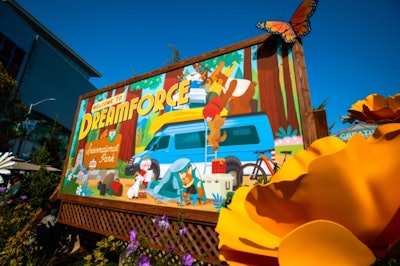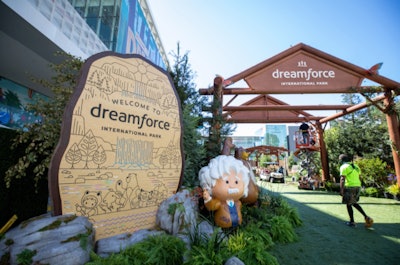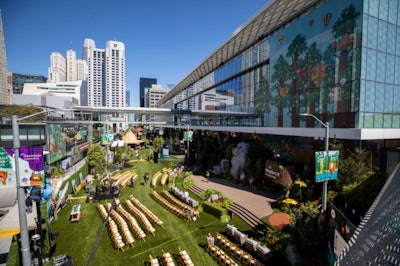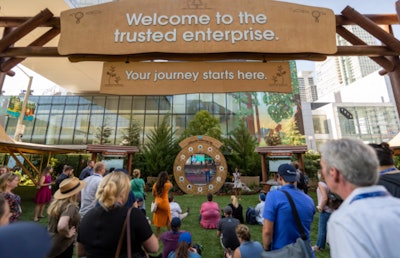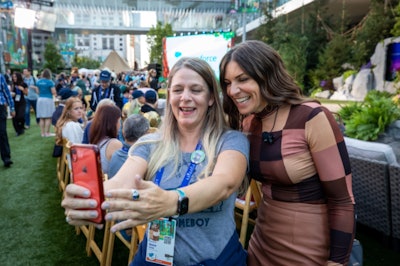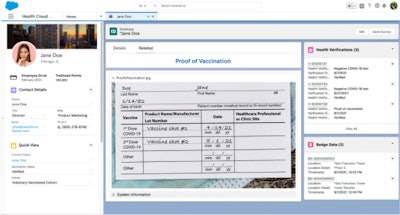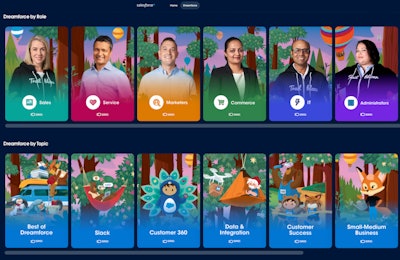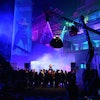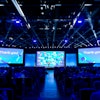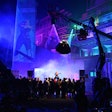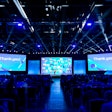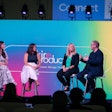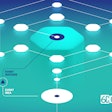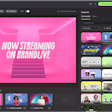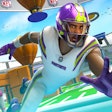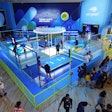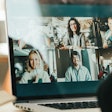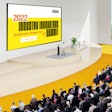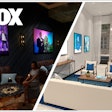 Each year, Salesforce's Dreamforce boasts a variation of a national park theme, with playful, bold designs that feature Dreamforce's recognizable animated characters.Photo: Courtesy of Salesforce
Each year, Salesforce's Dreamforce boasts a variation of a national park theme, with playful, bold designs that feature Dreamforce's recognizable animated characters.Photo: Courtesy of Salesforce
SAN FRANCISCO—For the past 18 months, event organizers, marketers and producers have continued to navigate the digital side of events, and with each successful virtual, in-person or hybrid gathering produced, our industry has grown to be more innovative now than ever. The latest example comes from Dreamforce 2021, the largest annual consumer-facing event from tech giant Salesforce, who managed to host a live event at the Moscone Center in San Francisco from Sept. 21-23 in tandem with a full-fledged, round-the-clock digital experience.
After going completely virtual in 2020—and, not to mention, setting a record for all-time stream views on Twitter, giving reigning title champ Beyoncé a run for her money—Salesforce's marketing and events team deemed hybrid as the right move for the brand for 2021's iteration.
"We think there are great experiences that can come out of a hybrid event," said Colin Fleming, Salesforce's senior vice president of global brand, events, content and customer marketing, who worked alongside experiential marketing and design company George P. Johnson for the production of Dreamforce. "We’ve long called Dreamforce our annual family reunion. It’s the ultimate manifestation of the Salesforce brand, so the in-person experience will always be a part of it. But moving Dreamforce to a hybrid event really opened up the globe for us. To see over 177 countries represented is pretty amazing, and that’s truly the benefit of the virtual side of events. We look at these experiences as exactly that: They are an opportunity to experience a brand, to come together, to network, to learn, to give back, to have fun.”
On-site, a little more than 1,000 invite-only attendees—playfully known as Trailblazers in the Salesforce community—gathered for two and a half days of educational programming, with ample celebrity appearances from the likes of Will Smith, Jane Fonda and Jason Sudeikis, to name a few, as well as live performances from The Foo Fighters and Lionel Richie. Topics of in-depth panel conversations included sustainability, equality, leadership and—a key point to each Dreamforce event—the tech company's new-to-market or soon-to-launch innovations, including Salesforce+, a new, free online streaming platform for live experiences and original on-demand content series from Salesforce, created for Dreamforce to host all live and on-demand content as a series of episodes post-event.  At Dreamforce 2021, a little over 1,000 attendees arrived at the Moscone Center in San Francisco for the two-and-a-half-day event, while the virtual experience through Salesforce+ garnered roughly 167,000,000 social streams and included attendees from 177 different countries.Photo: Courtesy of Salesforce
At Dreamforce 2021, a little over 1,000 attendees arrived at the Moscone Center in San Francisco for the two-and-a-half-day event, while the virtual experience through Salesforce+ garnered roughly 167,000,000 social streams and included attendees from 177 different countries.Photo: Courtesy of Salesforce
"There’s a lot of the event space that tends to be heading in one direction around a literal translation of the physical experience into a digital one, and we don’t think that’s the way forward. Instead of choosing what the natural extension was, like building an avatar-based expo hallway, we thought, we’re going to do things a little differently. We looked at it from a perspective of what would Netflix or Peloton do in this setting, and we referenced the consumer world as an analogy, and we built Salesforce+. It really allowed us to bring the magic of Dreamforce to the digital audience. We don't think the experience we did in 2020 fully delivered on that," said Fleming.
Online, remote attendees from 177 different countries logged into Salesforce+ to find more than 125 hours of original on-demand content and interact with other attendees, subject matter experts, product leaders and speakers, who could use chat functions to answer questions, moderate conversations and more. At-home guests could also use the platform's interactive features to submit questions to on-site speakers to answer in real time, connecting the in-person and virtual experience. To accommodate attendees from various time zones across the globe, Salesforce tapped into its international locations in Europe and Australia, passing production off to team members in Australia, then to Europe, then back to the U.S. team—resulting in a truly 24/7 virtual event, with the majority of the digital experience overseen from Salesforce's headquarters in San Francisco.
While the digital side of Dreamforce saw a ton of engagement, Fleming says that a goal for next year's event is to pave a better path for in-person and virtual attendees to connect with each other, rather than mostly in their own environments. A challenge the Salesforce team faced with the in-person audience came from planning a fully outdoor function: weather. To prepare, Fleming's team devised backup plans for 30 different scenarios so they could adjust their event protocols on the fly if weather conditions shifted. (Thankfully, the weather held out.)
The Salesforce team took that same over-prepared approach with them throughout the entire planning process. "We put more rigor into the planning than ever before, and our planning started earlier than it ever has," explained Fleming. "A lot of things at this year’s Dreamforce were firsts for us. Salesforce+ was a first. A two-day, always-on broadcast was a first for us. A global broadcast was a first for us. Of course, a lot of the eyeballs were on the in-person experience, but we know how to do Dreamforce. The broadcast side was foreign to us—that was where a lot of anxiety sat."
Most planning and preparation went into the live event's health and safety protocols, as Fleming noted that the safety of in-person guests was the No. 1 priority for the company. In addition to closely following updates of local government guidelines, Fleming's team held daily meetings over months with an epidemiologist to watch the Delta variant and develop a robust event safety protocol.
Naturally, Salesforce built out a new technology called Dreampass, which in-person attendees and all staff used to upload and verify their vaccination status (a requirement to attend). Once an attendee's vaccination status was manually approved, that action automatically triggered COVID-19 test kits to be sent out to each guest along with an email that included next-step instructions. In-person guests were required to test 96 and 72 hours leading up to the event, which was automatically recorded in Dreampass thanks to the technology's integration with the event's testing vendors. After all tests proved negative and vaccination status was verified, Salesforce's Vaccine Cloud generated a QR code (aka, Dreampass) to guests, who showed them to staff upon arrival and took an additional on-site test before entering.  Salesforce built new technology called Dreampass, which in-person attendees and all staff used to upload and verify their vaccination status (a requirement to attend).Photo: Courtesy of Salesforce
Salesforce built new technology called Dreampass, which in-person attendees and all staff used to upload and verify their vaccination status (a requirement to attend).Photo: Courtesy of Salesforce
“As event planners, we have to be thinking about vaccinations and testing now—that’s not just for health care providers exclusively. That’s for us, because this is going to be with us for quite some time. This is part of the new normal for event marketers,” explained Fleming.
With such a vigorous health safety protocol in place, he said, "While we planned for hesitation and concern, we received comfort and trust and happiness, frankly. Getting together for the first time in 19 months as our family reunion, it was special to see that the in-person experience does bring something that event marketers all know of and we’ve been missing, and we wanted to show the world we can do it safely."
The key to attendee happiness amid robust testing protocols? Over-communication. "Our No. 1 value as an organization is trust, and the way we built trust with our attendees was to show them deliberately what our protocol would look like, and that it would go above and beyond guidelines given out by the local or federal government. We did that by over-communicating so that no one felt they were sold the goods and it wasn’t accurate. We made it very clear that if you wanted to attend, this would be the protocol you’ll be subjected to. We made attendees do quite a lot, and they did it with a smile on their faces, and they were just happy to come together."
To event organizers seeking insight to pull off a similar hybrid experience, Fleming offers this advice:
1. Don’t underestimate the preplanning stage. "A broadcast digital setting is a much more complex scenario, so bring in expertise. We were fortunate to hire former executives and leaders of media companies to help us think through that," he said.
2. Embrace the dual experience between digital and in-person. "This is where the event marketing world will be going, and this is what we’re building. Think about events as a transformation rather than translation. The beauty of this new world allows for all kinds of things, but that doesn’t mean you have to walk away from what’s worked in the past.”
3. Health safety protocols have to be a part of the initial plan and pre-event marketing conversation. "It’s not something you can just outsource to a group. It has to be a part of your communication strategy, part of your planning strategy and part of your scenario planning.”
4. Use the technology available to you, and fully test it ahead of time. "We were fortunate as a technology company to be able to build and actually productize the technology we used for Dreamforce. Use best practices from the consumer world."
Keep scrolling for more photos from the guest safety-conscious event.
